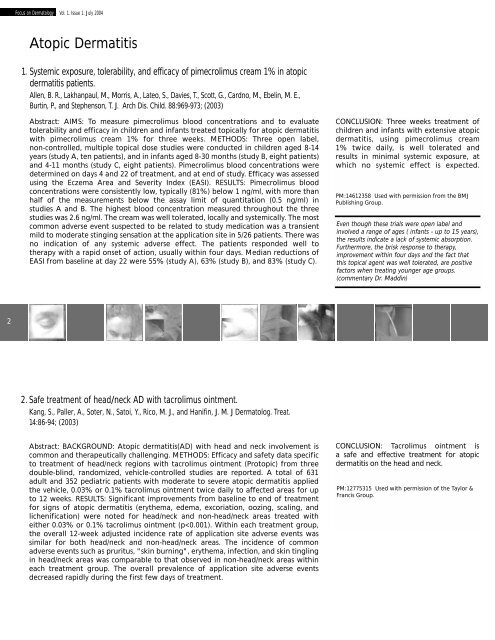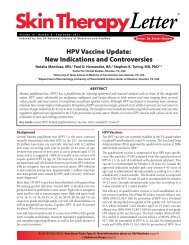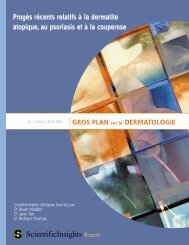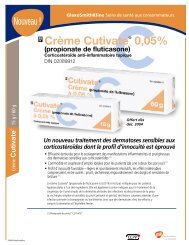focus on dermatology - Skin Therapy Letter
focus on dermatology - Skin Therapy Letter
focus on dermatology - Skin Therapy Letter
Create successful ePaper yourself
Turn your PDF publications into a flip-book with our unique Google optimized e-Paper software.
2<br />
Focus <strong>on</strong> Dermatology Vol. 1. Issue 1. July 2004<br />
Atopic Dermatitis<br />
1. Systemic exposure, tolerability, and efficacy of pimecrolimus cream 1% in atopic<br />
dermatitis patients.<br />
Allen, B. R., Lakhanpaul, M., Morris, A., Lateo, S., Davies, T., Scott, G., Cardno, M., Ebelin, M. E.,<br />
Burtin, P., and Stephens<strong>on</strong>, T. J. Arch Dis. Child. 88:969-973; (2003)<br />
Abstract: AIMS: To measure pimecrolimus blood c<strong>on</strong>centrati<strong>on</strong>s and to evaluate<br />
tolerability and efficacy in children and infants treated topically for atopic dermatitis<br />
with pimecrolimus cream 1% for three weeks. METHODS: Three open label,<br />
n<strong>on</strong>-c<strong>on</strong>trolled, multiple topical dose studies were c<strong>on</strong>ducted in children aged 8-14<br />
years (study A, ten patients), and in infants aged 8-30 m<strong>on</strong>ths (study B, eight patients)<br />
and 4-11 m<strong>on</strong>ths (study C, eight patients). Pimecrolimus blood c<strong>on</strong>centrati<strong>on</strong>s were<br />
determined <strong>on</strong> days 4 and 22 of treatment, and at end of study. Efficacy was assessed<br />
using the Eczema Area and Severity Index (EASI). RESULTS: Pimecrolimus blood<br />
c<strong>on</strong>centrati<strong>on</strong>s were c<strong>on</strong>sistently low, typically (81%) below 1 ng/ml, with more than<br />
half of the measurements below the assay limit of quantitati<strong>on</strong> (0.5 ng/ml) in<br />
studies A and B. The highest blood c<strong>on</strong>centrati<strong>on</strong> measured throughout the three<br />
studies was 2.6 ng/ml. The cream was well tolerated, locally and systemically. The most<br />
comm<strong>on</strong> adverse event suspected to be related to study medicati<strong>on</strong> was a transient<br />
mild to moderate stinging sensati<strong>on</strong> at the applicati<strong>on</strong> site in 5/26 patients. There was<br />
no indicati<strong>on</strong> of any systemic adverse effect. The patients resp<strong>on</strong>ded well to<br />
therapy with a rapid <strong>on</strong>set of acti<strong>on</strong>, usually within four days. Median reducti<strong>on</strong>s of<br />
EASI from baseline at day 22 were 55% (study A), 63% (study B), and 83% (study C).<br />
2. Safe treatment of head/neck AD with tacrolimus ointment.<br />
Kang, S., Paller, A., Soter, N., Satoi, Y., Rico, M. J., and Hanifin, J. M. J Dermatolog. Treat.<br />
14:86-94; (2003)<br />
Abstract: BACKGROUND: Atopic dermatitis(AD) with head and neck involvement is<br />
comm<strong>on</strong> and therapeutically challenging. METHODS: Efficacy and safety data specific<br />
to treatment of head/neck regi<strong>on</strong>s with tacrolimus ointment (Protopic) from three<br />
double-blind, randomized, vehicle-c<strong>on</strong>trolled studies are reported. A total of 631<br />
adult and 352 pediatric patients with moderate to severe atopic dermatitis applied<br />
the vehicle, 0.03% or 0.1% tacrolimus ointment twice daily to affected areas for up<br />
to 12 weeks. RESULTS: Significant improvements from baseline to end of treatment<br />
for signs of atopic dermatitis (erythema, edema, excoriati<strong>on</strong>, oozing, scaling, and<br />
lichenificati<strong>on</strong>) were noted for head/neck and n<strong>on</strong>-head/neck areas treated with<br />
either 0.03% or 0.1% tacrolimus ointment (p








